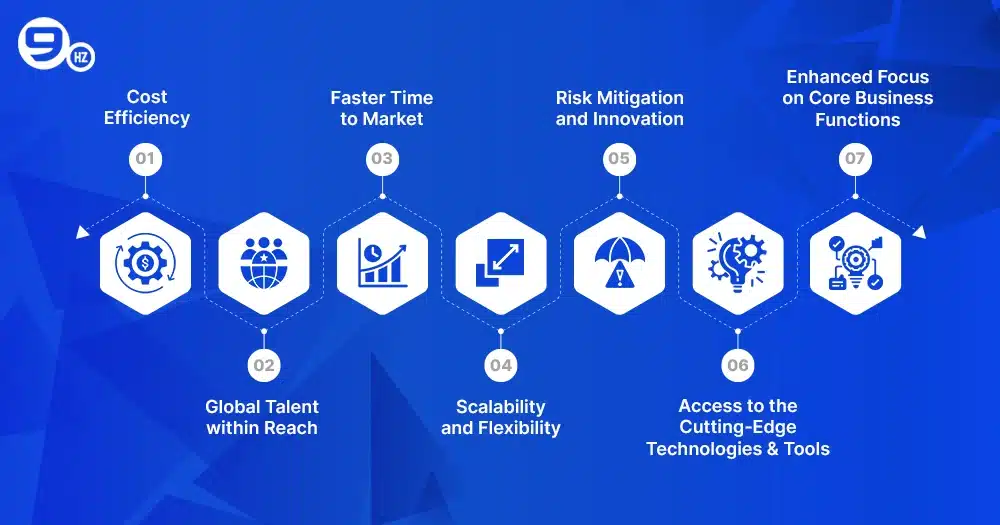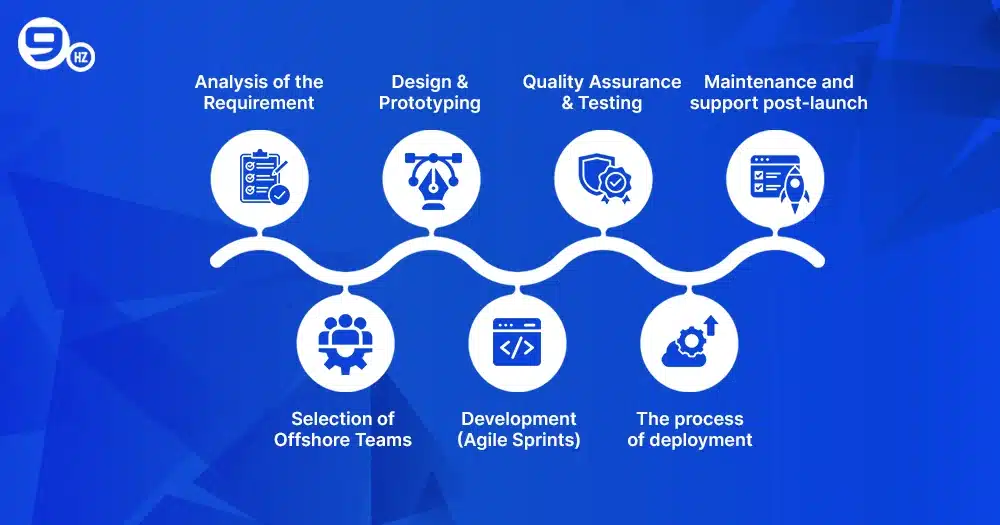Software delivery is more globalized than ever before. Imagine doubling its outputs, having access to world-class developers, and slashing your cost – all without increasing your office footprint! That’s exactly what the world’s leading businesses are achieving through offshore software development.
Offshore software development is not just about saving money! It’s a strategic move that lets businesses tap into a global talent pool, fast-track product timelines, and build resilience in today’s fast-changing tech arena.
The global managed services market hit $161 billion in 2025 and is expected to surpass $300 billion by 2027, reflecting the growing demand for offshore development in the upcoming future!
So, what exactly is offshore software development? Why are the world’s top tech giants, Fortune 500 enterprises, and ambitious startups treading this path in 2025? How can it benefit your business?
Ahead is a read that explores the offshore software development process, its core benefits, modern agile approaches, and how to calculate true offshore software development costs. Discover how offshore outsourcing can build your next digital product or app faster, smarter, and more affordably.
What Is Offshore Software Development?
Offshore software development is when you partner with a specialized offshore software development company or an independent crew of developers outside your country, often in regions like Eastern Europe, India, or Southeast Asia. The goal is to develop, test, and maintain the best quality software solutions.
The process is different from onshore development, where a development team is based out of your own country. Another alternative to offshore development is nearshore development with developers in a similar time zone or neighboring country. To put it simply, offshore software development is working with experts that are far away and across different time zones.
Here are the key parameters that set these models apart from each other –
1. Geographical Location
- Onshore development: In this process, teams work within the same country as the client.
- Nearshore development: Developers are located in nearby countries. They even often share regional proximity or borders.
- Offshore software development: It’s when a team of developers operates from distant countries, usually across continents.
2. Time Zone Overlap
- Onshore development: You can work together instantly without any delays.
- Nearshore development: Work hours match in most of the cases. So, meetings are usually easy to schedule.
- Offshore software development: It’s very rare that work hours overlap. Thus, teams communicate across different time zones. But projects can run round the clock!
3. Cost Structure
- Onshore development: It tends to be on the very expensive side because of the high local wages.
- Nearshore development: Definitely more affordable than the onshore development process. But cost savings could differ by country.
- Offshore software development: Lowest costs by recruiting experts from countries such as Ukraine, India, or the Philippines.
Empower Your Business with Expert Offshore Developers
4. Access to Talent
- Onshore development: It’s limited to the local experts only!
- Nearshore development: Extends access to the regional talent pool.
- Offshore software development: Bridges the gap between you and global talent or niche tech skills, which is impossible to find locally.
5. Communication & Collaboration
- Onshore development: Easiest to communicate as there are very little (if not zero) cultural divides or language barriers.
- Nearshore development: Limited issues pertaining to language or cultural differences. Also, it’s easy to travel to attend face-to-face discussions or meetings.
- Offshore software development: One may face challenges due to language/culture gaps. But you can champion them using robust cloud collaboration tools. If practiced properly, remote work practice can also help!
Key Benefits of Offshore Software Development
Offshore development is expected to hit a whopping $125.17 billion by 2029, growing at 20.1% annually! The IT outsourcing market across the globe will grow to $833.66 billion by 2033 with a 9.3% annual growth rate! Due to a shortage of talent or scalability, startups, banks, and SaaS companies are now leaning towards offshore development.
These clearly indicate that engaging an offshore software product development team is now a crucial part of the business strategy for many companies.
So, what’s really sparking this hype? These key advantages are the answers –
1. Cost Efficiency
Nothing comes close to offshore development when it comes to cost efficiency. Did you know it can minimize development costs by 30–70% compared to onshore or in-house development?
- Lower labor rates: The top destinations come up with competitive rates without compromising on quality.
- Flexible engagement: make sure that you hire only for the project scope you need, from a full offshore software development team to a single developer.
- Optimized infrastructure costs: Offshore teams often get access to pre-established tech environments, thus saving clients’ money on software, hardware, and workspace.
2. Global Talent within Reach
Offshore development helps you hire global talent by transcending geographical limits. When you get a chance to tap into a talent pool across the globe, you get these benefits.
- No local talent bottlenecks: There’s no limitation to local skillsets or talent shortages.
- Specialized expertise: It becomes considerably easier to find niche expertise for highly complex projects such as cloud computing, AI, cybersecurity, web development, mobile app development, and more.
- 24/7 development cycles: Development efficiency rises as teams work around the clock—leveraging time zone differences to speed up delivery.
3. Faster Time to Market
Another advantage of working with offshore development teams is rapid deployment and scale.
- Parallel projects: A huge number of projects can run in parallel, ensuring more rapid rollouts of products.
- Agile frameworks: With agile methodologies and fully dedicated team models, you can deliver features faster and with greater flexibility.
- Reduced hiring delays: You can avoid long onboarding processes or recruitment cycles.
4. Scalability and Flexibility
- Scale up or down quickly: One major benefit is that you can easily scale your team up for major launches. Reducing the team size upon completion of the project is also not difficult!
- On-demand expertise: Another big advantage is gaining access to specialized talent or additional development teams across regions for peak demands.
- Resource allocation: You can optimize resource usage for ever-evolving business objectives without any long-term commitment.
Build Scalable Software Solutions with Our Offshore Team
5. Risk Mitigation and Innovation
- Quality assurance: Offshore partners bring the best practices in project management, quality assurance, and software development processes.
- Business continuity: Offshore teams across multiple regions provide redundancy and minimize operational risk from local disruptions (like political events or power outages).
- A boost in innovation: Working with global teams brings fresh ideas besides helping you build more innovative products.
6. Access to the Cutting-Edge Technologies & Tools
- Offshore software development companies stay up-to-date with cutting-edge technologies, automated testing tools, and frameworks.
- Companies may use the latest tools like cloud infrastructure, DevOps automation, and advanced analytics without having to pay for research and development in-house.
7. Enhanced Focus on Core Business Functions
- Why If you outsource your development work, your employees may focus on strategic projects and the most important business goals instead of coding, testing, or maintaining infrastructure every day.
- This enhanced focus means better productivity, more customer satisfaction, and the long-term growth of your business.
Case Example:
A US fintech business needed to create mobile banking software, but it was hard to get workers in the area, and expenses were rising. They saved 60% on costs, sped up the process, and had their MVP out in less than four months by opting for offshore software product development in India. This beats their key competition to market.
Pro Tip:
There are many ambitious startups out there that rely on offshore software product development to launch faster, reduce costs, and build high-quality products they couldn’t really afford locally.
Agile Offshore Software Development: A Modern Approach
It’s not about handing off the requirements to an agile offshore software development team and then waiting for the finished product. Instead, it’s a process that is iterative, transparent, and very collaborative as it adds value at every level of the project.
Agile offshore software development is now the global norm for businesses that want to grow fast, be flexible, and stay ahead of the competition.
How Does Agile Offshore Software Development Work?
Agile offshore software development pulls together dispersed teams by offering them clear responsibilities, methods, and tools that work in real time. Here’s how this method changes the way teams work together and the results:
- Scrum and Sprints: Frameworks like Scrum are at the heart of agile offshore development. Sprints are short, targeted cycles that break up projects into smaller parts. They usually run two to four weeks. Each sprint provides you with a functional piece of the product, along with ways to get feedback. Such an arrangement lets teams working from other countries change direction quickly when priorities change or new ideas come up.
- Stand-Ups Every Day: Offshore software development teams have very brief, focused meetings every day, usually termed stand-ups, when they discuss their daily progress, pinpoint blockers, and how to set their priorities. Modern agile offshore software development teams use video conferences and chat platforms to stay in touch with clients and stakeholders in real time, even though they are in different time zones.
- Project Management Tools: Jira, Trello, and Asana are three of the most important tools for agile offshore development. You can use them to interact with each other, keep track of your work, deal with backlogs, and organize sprints. These solutions assist onshore and overseas teams in keeping track of the project’s progress, the next phases, and the due dates.
- Continuous Integration & Automated Testing: Agile offshore software development teams use continuous integration (CI), which means they regularly combine, test, and use new code. Automated testing tools help you find bugs early and speed up the releases. This makes sure that the product is always of excellent quality.
- Retrospectives and Continuous Improvement: After each sprint, agile offshore development teams undertake retrospectives. The group can discuss what worked, what didn’t, and how to make things better. This focus on continual learning makes sure that procedures are better every time they are implemented.
From Idea to Execution — We Build Software That Delivers Results
Why Is Agile Offshore Software Development Effective?
Agile offshore software solutions transform the vendor/client relationship into a successful partnership through –
- Active Client Involvement: Reviews and demos make sure that you are always involved in the process. This ensures each feature meets your expectations.
- Maximum Flexibility: Agile offshore development adapts extremely fast to the changing market trends or needs.
- Transparency and Predictability: You always stay in the loop of what’s done, the next targets, or the progress of the project.
Real-World Example:
Think about a US-based retail brand working with an offshore team located in Eastern Europe. With agile offshore software development, their daily stand-ups and sprint reviews are scheduled to align across time zones. Feedback is put into action within days – not weeks! And new features are released every two weeks. This helps the client stay ahead of the competition and respond quickly to customer needs.
Pro Tip:
It’s advisable that you choose an offshore software development partner that uses agile frameworks. It reduces risks, speeds up delivery, and keeps you updated on project progress.
The Offshore Software Development Process Explained
If you’re of the opinion that it’s not a big deal to achieve success in the offshore software development process, you may need to rethink! It’s important to follow a series of proven steps to deliver scalable, cost-effective, and robust digital solutions. Looking to launch a mobile app? Or, maybe a SaaS product or a full-scale web platform is on your mind? No matter what you need, follow this workflow to be consistent.
1.Analysis of the Requirement
The first thing to do for the project is to write down the business goals, user stories, and needs. This process normally involves talking to stakeholders, doing market research, and making sure that the technical feasibility is accurate so nothing is missing.
Pro Tip: Put in some work at the beginning so you need not overspend your money on correcting things later! Having clear and complete specifications is the most important element for a successful offshore software development process.
2.Offshore Software Development Team Selection
- Next, you pick an offshore software development company or team that has proper technical skills, knows your industry, and communicates well.
- You should now check reviews from people who have worked with them before, look at their portfolios, and check their technical certificates. If need be, consult with the experts or look at their skills to determine if they would be the right fit!
- Maintain clear communication protocols and use shared project management tools like Jira, Trello, etc. to streamline collaboration.
3. Design and Prototyping
- UX/UI designers develop wireframes, graphic mockups, and interactive prototypes so that those who are interested can try out the new product before it comes out.
- Early feedback sessions help avoid costly changes later. They also make sure that the final product is aligned with branding guidelines and user expectations.
Your Vision, Our Code — Offshore Development Made Simple
4. The Phase of Development
- The software development team employs agile approaches to write the code that makes it work. They normally work for two to four weeks in a row.
- This phase is about putting together the front-end and back-end, setting up the database, linking third-party APIs, and completing sprint reviews on a regular basis, are all part of this process.
- Regular stand-ups and sprint demos keep the customer informed, encourage transparency, and make it easy to alter direction as priorities change.
5. Checking and Verifying Quality
6. Putting it into practical Use
- The application is launched in a live environment, which might be a public cloud (AWS, Azure, GCP), an on-premises server, or a mix of the two, depending on what the client needs and compliance requirements.
- Deployment comprises checking security one last time, moving data, and setting up mechanisms to keep an eye on the real-world performance after launch.
7. Maintenance and Support After Launch
- After the launch, it’s important to keep a close tab on the systems, patch bugs, and add new features.
- Many organizations have an offshore development center to get continuous help, frequent upgrades, security patches, and scaling. This keeps their digital product healthy and competitive for years.
How Much Offshore Software Development Cost
Offshore software development cost is a major deciding factor when it’s about budgeting for a digital transformation. So, what really determines the costs? How can you keep your budget under control, that too without compromising quality? Let’s find out –
Offshore Software Development Pricing Models
- Hourly (Time & Material): You only pay for the hours you worked. Ideal for things that are continually changing.
- Fixed Price:The price and scope of work must be done ahead of time! Good for brief projects with clear goals.
- Dedicated Team Model: You pay a certain amount each month for a team of software engineers who work for you.
What Impacts Offshore Software Development Cost?
- Location of Your Offshore Partner: The US Prices are usually lower in the Philippines and India than in South America and Eastern Europe.
- Level of Technical Expertise: Making a simple web or mobile app is cheaper than learning how to use AI, blockchain, or cloud computing.
- Project Complexity & Scope: Costs go higher when there are big systems, special connectors, and security difficulties.
- Team Size and Structure: A bigger team and 24/7 support always cost more.
- Development Tools & Licenses: The price could go up if you need licenses and tools to develop advanced QA, project management systems, or cloud infrastructure.
Quick Table on Offshore Software Development Cost
| Region | Junior Dev (USD/hr.) | Senior Dev (USD/hr.) | Project Manager (USD/hr.) | QA (USD/hr.) | Avg. Cost for MVP (USD) |
|---|---|---|---|---|---|
| India | $15 – $30 | $25 – $60 | $35 – $65 | $18 – $40 | $15,000 – $40,000 |
| Eastern Europe | $22 – $45 | $40 – $80 | $50 – $90 | $25 – $50 | $40,000 – $80,000 |
| Latin America | $25 – $50 | $50 – $85 | $45 – $85 | $25 – $55 | $30,000 – $70,000 |
| Southeast Asia | $15 – $30 | $30 – $60 | $40 – $70 | $20 – $45 | $25,000 – $60,000 |
Note – The numbers mentioned above are ballpark estimates. Therefore, you should always request a customized quote from your chosen offshore software development company, tailored to your specific needs.
How to Choose the Right Offshore Software Development Company
To put the top benefits of OSD into real practice, you should choose the right offshore software development company. Ahead is a step-by-step guide on how to ace the deal –
1. Check their Portfolio and Experience
- Take out time to thoroughly review their previous projects. Review their industry expertise. Ask for their client testimonials.
- Don’t forget to check the kind of diversity they bring to their work. Seek work samples from similar fields. Find out how well they demonstrate reliability and innovation.
- Clearly mention your intended software solution, business processes, or outcomes at the very beginning. Specifically define the support you need with the tech stack, features, deadlines, etc.
Case Study: Among a number of offshore software developers claiming fame, The NineHertz deserves a special mention! This award-winning company has successfully delivered more than 1000 projects globally for clients across sectors like healthtech, fintech, e-commerce, and more. To learn why they deserve your time or trust, tap here – https://theninehertz.com/
2. Technical & Domain Expertise
- Find out whether the team specializes in your intended tech stack – web development, enterprise software, or mobile app development.
- Learn about their training programs, unique tech skills, or certifications. The better the clarity, the more chances of success!
3. The Process of Communication
- Choose an offshore team that’s proficient in English and transparent about their work.
- They should provide regular updates, responsive client service, and detailed project documentation.
- Your chosen offshore software development company should use tools like Microsoft Teams, Slack, etc. to support real-time interaction and bridge time zone differences.
4. Check Their Security Practice
- Choose an offshore partner certified by CMMI, ISO, and GDPR/SOC2 for optimal security and compliance.
- Try to gain an understanding of how your partner manages data privacy and intellectual property protection.
- Ask if they follow any policy to manage risks or comply with regulations.
5. Post-launch Support and Maintenance
- Find an offshore software development partner who can help you in the right way through ongoing maintenance, feature enhancements, or quick bug fixes.
- Take their SLAs (service-level agreements) into account. It’s important to check how quickly they respond to critical issues.
Pro Tip: It’s suggested that you should begin with a short-term contract or a pilot project before you commit to any long-term engagement with an offshore software development company.
Top Destinations for Offshore Software Development in 2025
Where you decide to build your digital products truly matters! Here are the best places to choose for offshore software development this year. They were chosen because they are cost-effective, have strong tech education systems, and boast a huge pool of talent from around the world.
India
- Offshore software development companies in India is among the top leaders across the globe!
- Pros: a large pool of talented experts (over 5 million developers), proficiency in English, and low costs.
- Notable areas of expertise: AI, mobile app development, and custom software solutions.
Ukraine
- Known for its technical skills and strong European work culture.
- Costs are a little higher than in India, but the country has top-notch software engineering talent.
- Poland, based in the EU, has gained a strong reputation for executing complicated projects successfully.
- Strengths: security, quality assurance, and enterprise software.
- It provides high-quality results at an affordable cost than Western Europe.
North American and EU clients mostly trust Ukraine’s developers to work with.
Poland
The Philippines
- A great place for English-speaking project management and customer service.
- A popular place for agile offshore software development and outsourcing business processes.
- Strong in mobile and web development, with competitive rates.
Some Other Famous Destinations
- Eastern Europe (Romania and Bulgaria): These destinations have earned trust mainly for their technical expertise. Also, their time zones align well with Western Europe.
- Latin America: Preferred by US companies for similar time zones and work culture.
- Vietnam: It’s increasingly becoming a go-to location for high-quality software development at affordable pricing.
Pro Tip: Don’t rush when choosing your offshore partner. Take ample time to compare multiple offshore software development rates, technical expertise, and time zone overlap. It’s only when you’re armed with right insights that you can collab with the best offshore development center service.
Common Challenges in Offshore Software Development and How to Overcome Them
Don’t deprive yourself of offshore software development unless you’re okay with lagging behind the competition! It can truly flip the script on how your business excel, thrive and succeed. However, it’s not without challenges, though. The good news is that with the right strategies you can champion them.
1. Communication Barriers
Challenge: Issues like differences in languages, remote work setup, or unclear requirements can cause misunderstandings.
Solution:
- Rely on offshore partners who are proficient in English. Also, they should maintain a transparent communication process.
- For daily updates, make use of advanced collaborative tools like Slack, Microsoft Teams, etc.
- Arrange video calls on a regular basis. Focus on maintaining detailed documentation.
2. Differences in Time Zone
Challenge: Feedback can take longer due to time zone differences. This could affect the decision-making process.
Solution:
- Choose an offshore software development partner with similar working hours.
- Set fixed hours for live collaboration.
- Schedule teams to cover round-the-clock coverage.
3. Quality Control
Challenge: Maintaining the same level of quality as your in-house team could be a challenge in some cases.
Solution:
- It’s important to implement more rigorous QA processes besides using automated testing tools.
- Reviewing the ongoing work daily and providing actionable feedback are important.
- To stay on the safe side, always begin with a pilot project to assess quality before scaling.
4. Data Security & Compliance
Challenge: It’s difficult to check if your offshore partner is maintaining the safety of your sensitive information or complying with international laws – from a distance!
Solution:
- Onboard a team that’s acquainted with your regulatory landscape, such as GDPR, HIPAA, and the like.
- Make sure that they have a strong data security procedure and NDAs in place.
5. Cultural Disconnect
Challenge: Some serious issues could crop up if your offshore partner fails to blend in with how your company works or its overall internal culture.
Solution:
- Hire top vendors, as they always invest in cultural training.
- Invest ample amounts of time and effort in relationship building.
- Encourage a collaborative and inclusive work culture to ensure everyone’s on the same page.
Pro Tip: To avert risk and reap more benefits, focus on setting clear project goals and effective communication from the word go!
Conclusion
The popularity of offshore software development continues to grow. Millions of businesses are relying on it to accelerate digital transformation, tap into global talent, and drive cost savings in 2025 and the years to come!
Whether you are an established enterprise modernizing legacy systems or a budding venture building a mobile app, the right offshore software development partner can help you conquer every milestone!
Brace up to embrace offshore software product development to navigate complex projects, champion resource constraints, and shift your focus on your growth. Let the expert offshore teams get everything covered – from need analysis to maintenance and deployment!
Wondering who you should trust? Collaborate with a reputable offshore software development company like The NineHertz right away! From tailored solutions to ongoing support and full-cycle development – get a premium offshore outsourcing service to set your business up for success.
FAQs
1. What is offshore software development and how does it work?
Offshore software development indicates the process of hiring a team in another country to build your software. They work remotely using collaboration tools, agile frameworks, and regular updates.
2. How does agile offshore software development improve project outcomes?
Agile offshore development utilizes sprints and regular feedback to deliver fully flexible and top-notch results across time zones.
3. What factors affect offshore software development cost?
Good question! Factors that primarily affect offshore software development are location, project complexity, team size, duration, pricing models (hourly/fixed/dedicated), etc.
4. Why should businesses choose offshore software product development?
You should opt for offshore development to scale fast, access diverse talent, slash costs, and launch quicker.
5. How to select the best offshore software development company?
Check the offshore company’s portfolio, technical expertise, security measures, communication process, and after-launch support. For the best result, you can start with a small project.
Great Together!











